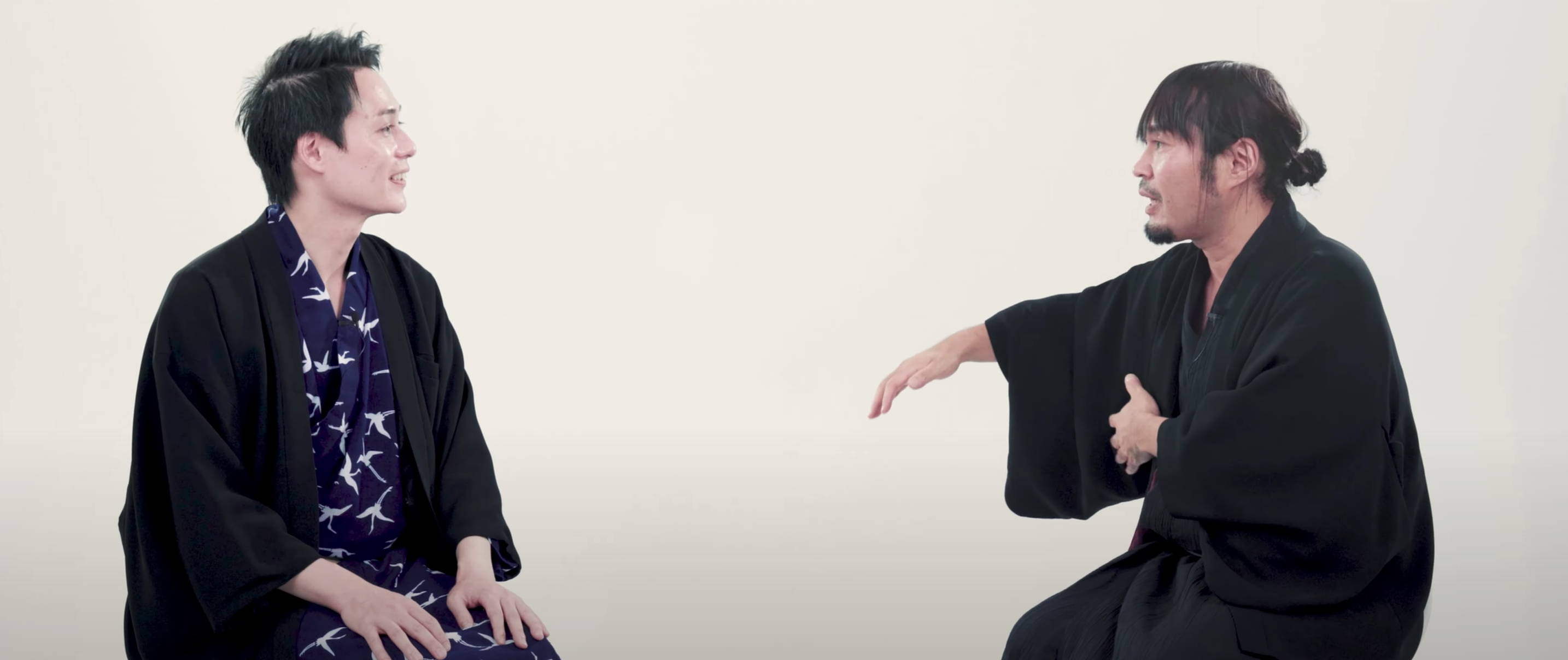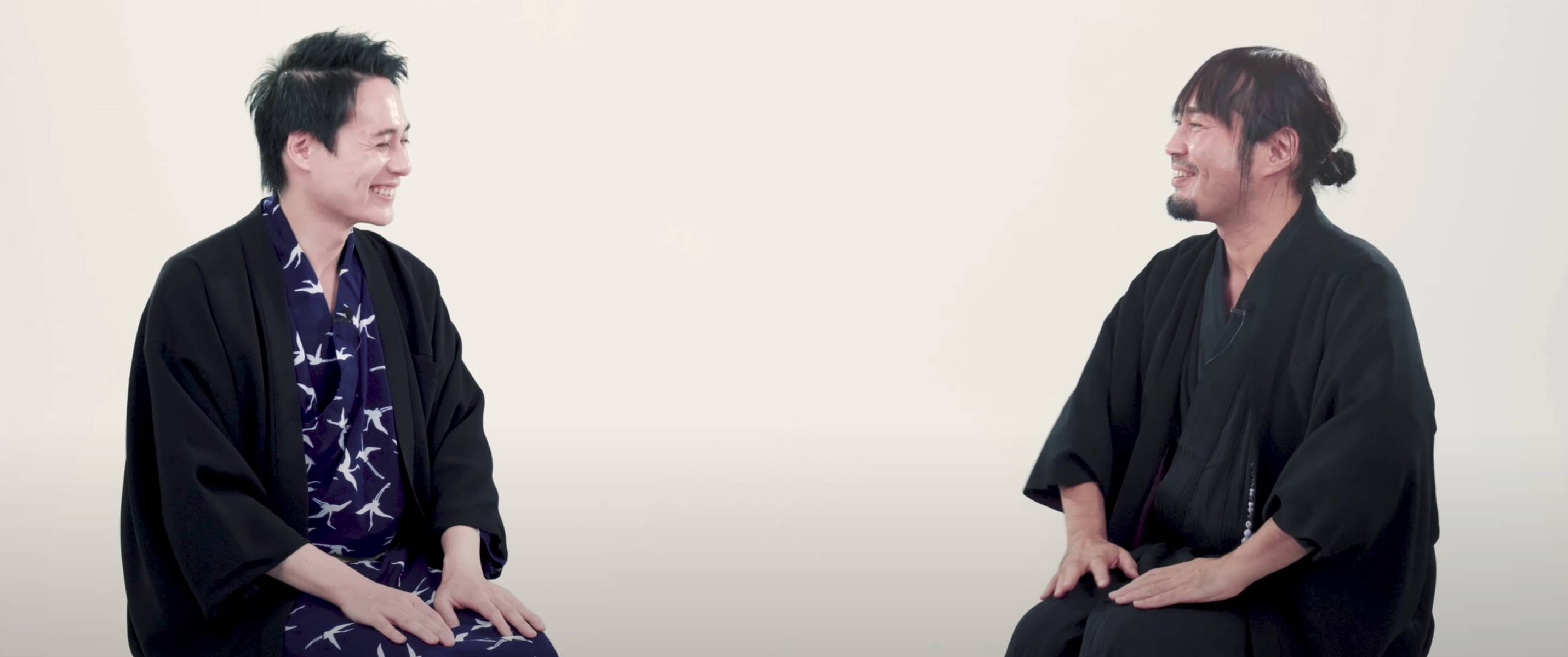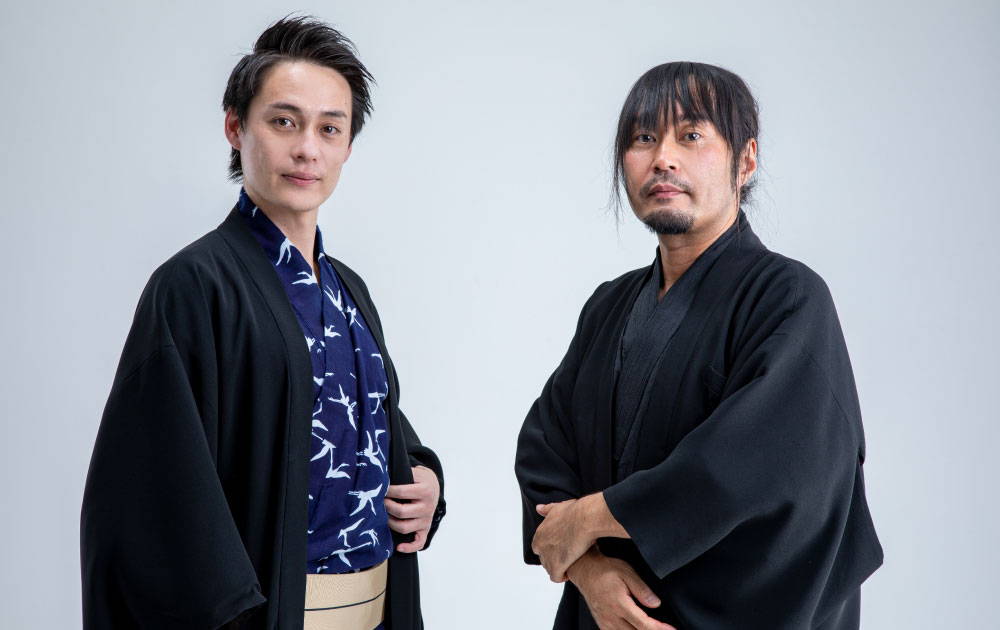
MAY 12, 2023
Special interview
Sakiju tayu Toyotake
豊竹咲寿太夫
×
Takahiro Sato
佐藤貴浩
# 03
Creators cross talking
Ambassador × Designer
Ambassador
×
Designer
"The Future of tradition"
Tak:
Also, the way we got to know each other, is Ningyo Joruri Bunraku.
...I also got to wear a yukata by Mr. Sakiju.
Actually, Mr.Sakiju and I are wearing our Samurai Mode Jackets this time.
In addition to this, Mr. Sakiju is wearing our new skirts and shirts.
We also have photoshooting before and after this interview.
What about KUDEN clothing?
As for me, I love kimonos,
Actually, Mr. Sakiju dressed me in this.
It was quite difficult, Some of our customers can dress themselves,
but they are mothers, and others work and cannot wear kimonos very often.
People who can't wear kimonos because too busy buy our clothing.
Some people say, "This is what I wanted to wear."
Also, people from overseas may not even know that there is such a thing as dressing "Kitsuke."
They say, “I can wear a kimono," "No, a kimono is..." and so on.
They intend to wear it comfortably.
but many of them don't know the actual technique.
These people said, "I can wear this."
In fact, we have a customer from France.
They say,Vintage kimonos are also sold in France.
But Japanese women in the past were petite, weren't they?
Sakiju:
I think so.
Tak:
So vintage kimonos don't easily fit foreign women.
Sakiju:
Yes, that's right.
Tak:
She said she was frustrated for a long time because she couldn't wear it because of that.
But she said she could wear our jackets.
In fact, she already has three jackets.
Sakiju:
That's great.
Tak:
She wore it on a trip to Kyoto and got compliments.
Sakiju:
Oh wow.That's great.
Tak:
When asked where this was from, she said, "In Japan, at KUDEN."
They really enjoy their own kimono life.
I was happy because I made it for that purpose, Wearing a kimono as an everyday item, as a way of doing things, From your point of view, what do you think of KUDEN's clothes?
I'm getting nervous.
Sakiju:
When it comes to kimonos I think people tend to think of kimono as a hurdle to overcome.
We live in yukata on a daily basis, Also live in yukata all the time in the dressing room, etc.
There are quite a lot of opportunities to wear kimono.
I am a person who almost always has a kimono in my daily life, From that kind of person's point of view,
Kimono is, after all, a garment originally worn by the Japanese.
In a certain story, There is a story that says a kimono is like a suit.
I thought it was a good fit, From formal to casual.
Yukata are very casual,
When it comes to formal wear,
In the old days, people had a family crest.
Wear a black crested kimono with such a thing, and wear hakama. If they are a man.
If a person is a samurai, he or she wears a haori or a katabira.
It's a very formal garment, even to that point.
It is the equivalent of a tuxedo.
I think it is a very versatile culture.
It was originally the clothing that townspeople wore in their daily lives.
So, I think there are a lot of hurdles to overcome in dressing for the modern world.
I wanted it to be something that could be worn easily.
Tak:
I think you are right too.
Sakiju:
And it is hard to find such things.
Even if you usually wear it to town It is not easy for many people to wear them themselves,
Even to tie a single obi, In the old days, it was a part of daily life,
It was a matter of course, but after the Meiji Restoration clothing gradually changed,
As western clothes were introduced and kimonos were moved away.
After all, tying an obi is no longer a part of my daily life.
Tak:
Indeed. It's only when you go to an inn.
Sakiju:
Yes, it is.
So what was originally a routine, Nowadays, it has become a hurdle.
What do you call these casual kimonos these days?
Tak:
It's coming out a little bit step by step.
Sakiju:
Yes, I know. I see a little bit of that kind of clothing,
I was able to wear it today, and it's so...It fits me well, doesn't it?
Tak:
Thank you so much.
Pattern, As mentioned by Mr. Sakiju just now,
My first KUDEN outfit is also kimono-like, I hope it will give people the courage to wear traditional kimonos, or give them a chance to start wearing kimonos.
Sakiju:
I think so too.
Tak:
When it comes to kimono-like clothing, the skirt in this case would have been made in the hakkake style,
and these parts would normally be taken out.
Sakiju:
Yes, there are many that are generally not.
Tak:
But I want to keep this one.
Sakiju:
Glad to hear it.
Tak:
It's actually easier to move without it,
also from a designer's point of view, we can lower the price.
Sakiju:
Is that so?
Tak:
I'd like to reduce the amount of fabric...or something like that.
Sakiju:
I see. So that's what you're talking about in the first thing.

Tak:
Actually, sewing here was very difficult.
It droops.
Because different fabrics are sewn together, This is something that can be done because of Japan's great sewing technology, Why do we keep this design?
They are the clothes that lead people to appreciate the original qualities of the kimono.
Sakiju:
That makes me happy.
I often see a lot of kimono-like clothing being sold these days, They don't have kimono sleeves, for example.
Kimono was originally something that could be laid flat and folded. That's how they started out, so I'm glad they have sleeves.
Tak:
I am often asked why I don't take it, but I didn't want to.
However, the climate is changing nowadays, and some of our customers are from hot countries.
In fact, this Miyatsu-guchi is not found in men's kimonos, But we intentionally leave it open to match the modern climate.
Kimonos are T-shape or yakko-shape.
Sakiju:
Yes, I know. Like I said before,
It's something that can be folded flat, so it's all made in straight lines.
Therefore, when you put it on, it often feels loose.
Tak:
I studied patterns for a year, studied a lot of kimonos, made them like a shoulder drop.
For example, if you take one, This is an ordinary yukata,
The items that can be placed flat end up like this, If you put this jacket on, the shoulders will fall down,
Sakiju:
Really. When I wear it, it fits perfectly on my body, doesn't it?
It feels great.
Tak:
Also, as Mr.Sakiju just said, I think it's great to be a kimono designer,
It is one design.
Sakiju:
Right.
Tak:
From formal to casual.
Such clothes are hard to find.
There is a Shu-Ha-Ri (in-on-out) as an inheritor of culture.
I think it is good to have kimonos that suit the modern climate and lifestyle.
Sakiju:
I think it is good.
Tak:
Since I made this with a wish.
I am so happy to be praised by Mr.Sakiju.
I thought it looked good on you.
Sakiju:
Thank you very much.
From the point of view of someone who wears a kimono,
I am afraid that the culture of kimono itself will disappear.
Originally, it was about 150 years before the Japanese wore clothes.
For 1,000 years, 2,000 years.
Japanese people have been wearing them for a long time, so I don't want them to disappear.
However, the kimono itself has been updated since around the Muromachi period,
The form definitely differs from era to era, too.
So now, There are various rules.
Kimonos are considered to be.
This one, so to speak.
It was made from the end of the Edo period to the Meiji period.
In the Showa period when there was a little kimono boom.
There is a kind of lofty rule While protecting this kind of thing,
I believe that in order for kimono culture to permeate.
I think it is necessary to update it in line with the times.
Tak:
You are right.
Sakiju:
The shoulders should be in a shape that fits comfortably with this pattern.
Now that the weather in Japan is getting hotter and hotter,
I don't mind if here are open or not.
So, if we follow the original rule,
we tend to fall into the concept of "Kimono for men are not allowed to be opened".
When we think about how the culture of the kimono will evolve in the present.
So, it is still a good idea to think about, It fits our lifestyle at the time.
I'm very happy to update the way we do things.
Tak:
I love kimonos too, but I can't wear them very well.
I had a problem, and seeing my mother's memento reminded me of it.
The fact that there are people who are worried about the same things as me.
I also know that you are also struggling with many things, such as being a caregiver.
I want to wear it,
but I don't want to go through the hassle of wearing it...
Sakiju:
Yes, it is.
Tak:
There are often tips on how to dress kimono, such as,
"It's easy to dress this way," but this is not the case.
Sakiju:
I think so.
Tak:
It is a matter of feelings,
When I put on one of these, I felt very brave.
It's really as Mr. Sakiju said, As long as we don't make the mistake of TPO.
I want to enjoy myself more freely.
Sakiju:
I really think that is true.
Tak:
I want to learn both.
I've made friends with Mr.Sakiju, too.
I would like to wear a kimono and go to see your performance with customers.
Sakiju:
That would be great to see happen.
Tak:
We are talking about having such an event,
There, of course, we would do it formal.
Afterwards, I would go a little more casual.
I thought that having fun was the most important thing.
Sakiju:
Yes, that is right.
Tak:
Last topic,
You are going through a difficult time at such a young age.
What are your dreams for the future?
Dreams for the future of ningyo joruri, or even your own dreams.
Please tell us your thoughts on the future.

Sakiju:
This is a bit similar to what I just said.
Ningyo joruri and bunraku, the cultivation of this art form.
Since the Genroku era in the Edo period, been taking over for a long time,
What has been passed down from generation to generation is still being practiced today.
If it doesn't remain in the future for the next 100 or 200 years, it will be meaningless.
First of all, we want to preserve it,
And with that, we're still working on new pieces and things like that.
There are a number of new works, but one of them I would like to leave a future in which one of them will be a classic when people watch it for the next 100 years.
I would like to leave such a future behind.
Tak:
From now, we are going to see new one?
Sakiju:
It would be nice to see it.
Tak:
We are looking forward to your new work, Mr.Sakiju.
Sakiju:
Just like the story of the kimono.
It's not about preserving the culture itself or sticking to the old.
I don't mean that we should only look at the old things.
Create something that fits the perspective of people today.
when it was seen from the future, it was contemporary at the time.
it will be a classic from the future.
I want to leave something like that behind.
Tak:
When I heard the talk of Mr. Sakiju...
I can sense your power and desire to have fun.
Also feel that you want people to enjoy the show.
I think you draw pictures and introduce stories and bunraku,
What people enjoy nowadays and what they enjoyed 100 years ago are different.
I felt your wish to preserve traditional manners and build a form of ningyo joruri that can be enjoyed by people today.
Sakiju:
You are so right.
Tak:
I feel such a passion for it...
I am looking forward to seeing new work.
Sakiju:
Thank you very much.
So, In the past, people then might have laughed or cried
in different ways than we do now.
They may have sympathized in different ways than we do now,
The fact that it has remained all these years means that there are parts of that story that we can sympathize with, even if we look at it from a different point of view in the period of time.
Tak:
You mean universal.
Sakiju:
The universality of it is,
Even if it is updated in each era. In the same block of time, There is something that can be picked up
I think this is the universality.
Even when I tell people today about the classical stuff I do, I try to think about
what people today will be able to sympathize with when they see it, I introduce the synopsis of the stories, or I feature them when I draw illustrations as a hobby.
Tak:
I just had a look at the book,
there are a lot of things in it, I thought that you were building up your performance while thinking about how you should perform.
Thank you for your time today.
Sakiju:
Thanks for your time too.
Tak:
I have a lot more questions for the second edition.
I look forward to working with you. Thank you very much today.
Sakiju:
Best regards and thank you.
Tak:
Thank you all for your kind attention.


— Everything has been passed down from generation to generation through repeated changes.
豊竹咲寿太夫
[Greeting]
A kimono is 'something to wear'. Very simple indeed.
It is inevitable that the style of what we wear changes with the passage of time.
Universality and innovation exist at the same time in the functional beauty of the kimono, which is sublimated into the modern life we live, backed by the functional beauty that accompanied the life in the past.
There is no boundary in the irreversible flow of time between the old and the new, and everything has been passed down from generation to generation through repeated changes.
That is the oral tradition, KUDEN.
Welcome, come on, be with us.
↓Click here to visit our ambassador page






